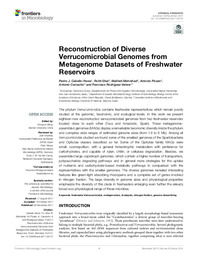Por favor, use este identificador para citar o enlazar este ítem:
https://hdl.handle.net/11000/4838Registro completo de metadatos
| Campo DC | Valor | Lengua/Idioma |
|---|---|---|
| dc.contributor.author | Cabello Yeves, Pedro J. | - |
| dc.contributor.author | Ghai, Rohit | - |
| dc.contributor.author | Mehrshad, Maliheh | - |
| dc.contributor.author | Picazo, Antonio | - |
| dc.contributor.author | Camacho, Antonio | - |
| dc.contributor.author | Rodríguez Valera, Francisco | - |
| dc.contributor.other | Departamentos de la UMH::Producción Vegetal y Microbiología | es |
| dc.date.accessioned | 2018-09-28T08:45:33Z | - |
| dc.date.available | 2018-09-28T08:45:33Z | - |
| dc.date.created | 2017-10-18 | - |
| dc.date.issued | 2018-09-28 | - |
| dc.identifier.uri | http://hdl.handle.net/11000/4838 | - |
| dc.description.abstract | The phylum Verrucomicrobia contains freshwater representatives which remain poorly studied at the genomic, taxonomic, and ecological levels. In this work we present eighteen new reconstructed verrucomicrobial genomes from two freshwater reservoirs located close to each other (Tous and Amadorio, Spain). These metagenomeassembled genomes (MAGs) display a remarkable taxonomic diversity inside the phylum and comprise wide ranges of estimated genome sizes (from 1.8 to 6 Mb). Among all Verrucomicrobia studied we found some of the smallest genomes of the Spartobacteria and Opitutae classes described so far. Some of the Opitutae family MAGs were small, cosmopolitan, with a general heterotrophic metabolism with preference for carbohydrates, and capable of xylan, chitin, or cellulose degradation. Besides, we assembled large copiotroph genomes, which contain a higher number of transporters, polysaccharide degrading pathways and in general more strategies for the uptake of nutrients and carbohydrate-based metabolic pathways in comparison with the representatives with the smaller genomes. The diverse genomes revealed interesting features like green-light absorbing rhodopsins and a complete set of genes involved in nitrogen fixation. The large diversity in genome sizes and physiological properties emphasize the diversity of this clade in freshwaters enlarging even further the already broad eco-physiological range of these microbes | en |
| dc.description.sponsorship | FR-V was supported by grant “VIREVO” CGL2016-76273-P [AEI/FEDER, EU], (cofunded with FEDER funds) | - |
| dc.description.sponsorship | Acciones de dinamización “REDES DE EXCELENCIA” CONSOLIDERCGL2015- 71523-REDC from the Spanish Ministerio de Economía, Industria y Competitividad and PROMETEO II/2014/012 “AQUAMET” from Generalitat Valenciana | - |
| dc.description.sponsorship | Valenciana.MMwas supported by the Czech Academy of Sciences (Postdoc program PPPLZ application number L200961651) | - |
| dc.description.sponsorship | RG was supported by the Grant Agency of the Czech Republic by the research grant -04828S | - |
| dc.description.sponsorship | The authors would like to thank Ana-Belén Martin- Cuadrado, Riccardo Rosselli, and Rafael González-Serrano for assistance with sampling and filtration | - |
| dc.format | application/pdf | en |
| dc.format.extent | 17 | es |
| dc.language.iso | eng | en |
| dc.rights | info:eu-repo/semantics/openAccess | en |
| dc.subject | freshwater Verrucomicrobia | en |
| dc.subject | metagenomics | en |
| dc.subject | rhodopsin | en |
| dc.subject | nitrogen fixation | en |
| dc.subject | genome streamlining | en |
| dc.subject.other | 579 - Microbiología | es |
| dc.title | Reconstruction of Diverse Verrucomicrobial Genomes from Metagenome Datasets of Freshwater Reservoirs | es |
| dc.type | info:eu-repo/semantics/article | en |
| dc.identifier.doi | 10.3389/fmicb.2017.02131 | - |
| dc.relation.publisherversion | https://doi.org/10.3389/fmicb.2017.02131 | - |

Ver/Abrir:
Reconstruction of Diverse Verrucomicrobial Genomes from Metagenome Datasets of Freswater Reservoirs.pdf
8,05 MB
Adobe PDF
Compartir:
 La licencia se describe como: Atribución-NonComercial-NoDerivada 4.0 Internacional.
La licencia se describe como: Atribución-NonComercial-NoDerivada 4.0 Internacional.
.png)